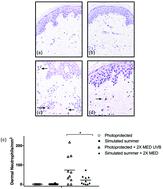当前位置:
X-MOL 学术
›
Photochem. Photobiol. Sci.
›
论文详情
Our official English website, www.x-mol.net, welcomes your feedback! (Note: you will need to create a separate account there.)
Photoprotection conferred by low level summer sunlight exposures against pro-inflammatory UVR insult.
Photochemical & Photobiological Sciences ( IF 3.1 ) Pub Date : 2020-05-19 , DOI: 10.1039/c9pp00452a S J Felton 1, 2 , B B Shin 1, 2 , R E B Watson 1, 2 , R Kift 3 , A R Webb 3 , L E Rhodes 1, 2
Photochemical & Photobiological Sciences ( IF 3.1 ) Pub Date : 2020-05-19 , DOI: 10.1039/c9pp00452a S J Felton 1, 2 , B B Shin 1, 2 , R E B Watson 1, 2 , R Kift 3 , A R Webb 3 , L E Rhodes 1, 2
Affiliation

|
Tanning (melanisation and epidermal thickening) is a photoprotective response to solar UVR exposure, but it's unclear to what degree low-level exposures induce this in light-skin individuals, or whether this modifies the histological inflammatory response to UVR. Objectives were to examine if, in light-skin people, a simulated summer's casual sunlight exposures induces (i) melanogenesis, (ii) epidermal thickening and (iii) demonstrable protection against both clinical (erythema) and histological (neutrophil infiltration) impacts of higher-level, pro-inflammatory UVR challenge. A UVR intervention study was designed to simulate a summer's brief sunlight exposures (95% UVA, 5% UVB) as can provide sufficient vitamin D. Ten healthy adults of phototype II, median 47 years (range 30–59 years), 2 male/8 female, received 1.3 SED 3× weekly for 6 weeks, and were subsequently challenged with 2× personal MED of UVB on small areas of UVR-exposed and UVR-protected buttock skin. Skin erythema and pigmentation were measured spectrophotometrically. Punch biopsies were taken from (i) unexposed skin (ii) skin following the ×18 low-level UVR exposures and (iii) skin at 24 h following the 2 × MED challenge, with skin sections evaluated for epidermal thickness, and for neutrophil infiltration by immunohistochemistry. The 6-weeks’ UVR exposures significantly increased skin pigmentation, skin lightness (L*) reducing from 69.37 (SD 2.8) to 65.52 (2.33) at course-end (p < 0.001), and stratum corneum thickness rising from 29.3 (9.59) to 41.5 (12.7)μm (p < 0.05); there was no influence on neutrophil numbers. Following the pro-inflammatory (2× MED) UVR challenge, there was a small (18%) reduction in erythema but a proportionately greater (71%) reduction in neutrophil infiltration in skin prior-exposed to the UVR course compared with photoprotected skin (both p < 0.05). Thus, findings add to information on risk-benefit of low-level sunlight exposure. Even very light-skin people show measurable although modest photoprotective responses to repeated low-dose UVR; greater impact is seen on histological than clinical inflammation.
中文翻译:

由低水平夏季阳光照射赋予的光保护作用,可抵御促炎性 UVR 损伤。
晒黑(黑色素化和表皮增厚)是对太阳 UVR 暴露的光保护反应,但尚不清楚低水平暴露在浅色皮肤个体中在多大程度上引起这种情况,或者这是否会改变对 UVR 的组织学炎症反应。目的是检查在浅色皮肤的人中,模拟夏季的随意阳光照射是否会引起 (i) 黑色素生成,(ii) 表皮增厚和 (iii) 对临床(红斑)和组织学(中性粒细胞浸润)影响的明显保护。 - 水平,促炎性 UVR 挑战。UVR 干预研究旨在模拟夏季短暂的阳光照射(95% UVA,5% UVB),因为它可以提供足够的维生素 D。十名 II 型健康成年人,中位年龄 47 岁(范围 30-59 岁),2 名男性/女8人,收1人。3 SED 每周 3 次,持续 6 周,随后在暴露于 UVR 和受 UVR 保护的臀部皮肤的小面积上用 2 倍个人 MED 的 UVB 进行攻击。用分光光度法测量皮肤红斑和色素沉着。穿刺活检取自 (i) 未暴露的皮肤 (ii) 18 倍低水平 UVR 暴露后的皮肤和 (iii) 2 倍 MED 攻击后 24 小时的皮肤,评估皮肤切片的表皮厚度和中性粒细胞浸润通过免疫组织化学。6 周的 UVR 暴露显着增加了皮肤色素沉着、皮肤亮度(穿刺活检取自 (i) 未暴露的皮肤 (ii) 18 倍低水平 UVR 暴露后的皮肤和 (iii) 2 倍 MED 攻击后 24 小时的皮肤,评估皮肤切片的表皮厚度和中性粒细胞浸润通过免疫组织化学。6 周的 UVR 暴露显着增加了皮肤色素沉着、皮肤亮度(穿刺活检取自 (i) 未暴露的皮肤 (ii) 18 倍低水平 UVR 暴露后的皮肤和 (iii) 2 倍 MED 攻击后 24 小时的皮肤,评估皮肤切片的表皮厚度和中性粒细胞浸润通过免疫组织化学。6 周的 UVR 暴露显着增加了皮肤色素沉着、皮肤亮度(L *) 在疗程结束时从 69.37 (SD 2.8) 减少到 65.52 (2.33) ( p < 0.001),角质层厚度从 29.3 (9.59) 增加到 41.5 (12.7)μm ( p < 0.05);对中性粒细胞数量没有影响。在促炎 (2x MED) UVR 激发后,与光保护皮肤相比,红斑略有减少 (18%),但在暴露于 UVR 过程中的皮肤中,中性粒细胞浸润的减少比例更大 (71%)。两者p < 0.05)。因此,研究结果增加了关于低水平阳光照射的风险收益的信息。即使是皮肤很浅的人,对反复的低剂量 UVR 也表现出可测量但适度的光保护反应;对组织学的影响比对临床炎症的影响更大。
更新日期:2020-05-19
中文翻译:

由低水平夏季阳光照射赋予的光保护作用,可抵御促炎性 UVR 损伤。
晒黑(黑色素化和表皮增厚)是对太阳 UVR 暴露的光保护反应,但尚不清楚低水平暴露在浅色皮肤个体中在多大程度上引起这种情况,或者这是否会改变对 UVR 的组织学炎症反应。目的是检查在浅色皮肤的人中,模拟夏季的随意阳光照射是否会引起 (i) 黑色素生成,(ii) 表皮增厚和 (iii) 对临床(红斑)和组织学(中性粒细胞浸润)影响的明显保护。 - 水平,促炎性 UVR 挑战。UVR 干预研究旨在模拟夏季短暂的阳光照射(95% UVA,5% UVB),因为它可以提供足够的维生素 D。十名 II 型健康成年人,中位年龄 47 岁(范围 30-59 岁),2 名男性/女8人,收1人。3 SED 每周 3 次,持续 6 周,随后在暴露于 UVR 和受 UVR 保护的臀部皮肤的小面积上用 2 倍个人 MED 的 UVB 进行攻击。用分光光度法测量皮肤红斑和色素沉着。穿刺活检取自 (i) 未暴露的皮肤 (ii) 18 倍低水平 UVR 暴露后的皮肤和 (iii) 2 倍 MED 攻击后 24 小时的皮肤,评估皮肤切片的表皮厚度和中性粒细胞浸润通过免疫组织化学。6 周的 UVR 暴露显着增加了皮肤色素沉着、皮肤亮度(穿刺活检取自 (i) 未暴露的皮肤 (ii) 18 倍低水平 UVR 暴露后的皮肤和 (iii) 2 倍 MED 攻击后 24 小时的皮肤,评估皮肤切片的表皮厚度和中性粒细胞浸润通过免疫组织化学。6 周的 UVR 暴露显着增加了皮肤色素沉着、皮肤亮度(穿刺活检取自 (i) 未暴露的皮肤 (ii) 18 倍低水平 UVR 暴露后的皮肤和 (iii) 2 倍 MED 攻击后 24 小时的皮肤,评估皮肤切片的表皮厚度和中性粒细胞浸润通过免疫组织化学。6 周的 UVR 暴露显着增加了皮肤色素沉着、皮肤亮度(L *) 在疗程结束时从 69.37 (SD 2.8) 减少到 65.52 (2.33) ( p < 0.001),角质层厚度从 29.3 (9.59) 增加到 41.5 (12.7)μm ( p < 0.05);对中性粒细胞数量没有影响。在促炎 (2x MED) UVR 激发后,与光保护皮肤相比,红斑略有减少 (18%),但在暴露于 UVR 过程中的皮肤中,中性粒细胞浸润的减少比例更大 (71%)。两者p < 0.05)。因此,研究结果增加了关于低水平阳光照射的风险收益的信息。即使是皮肤很浅的人,对反复的低剂量 UVR 也表现出可测量但适度的光保护反应;对组织学的影响比对临床炎症的影响更大。



























 京公网安备 11010802027423号
京公网安备 11010802027423号